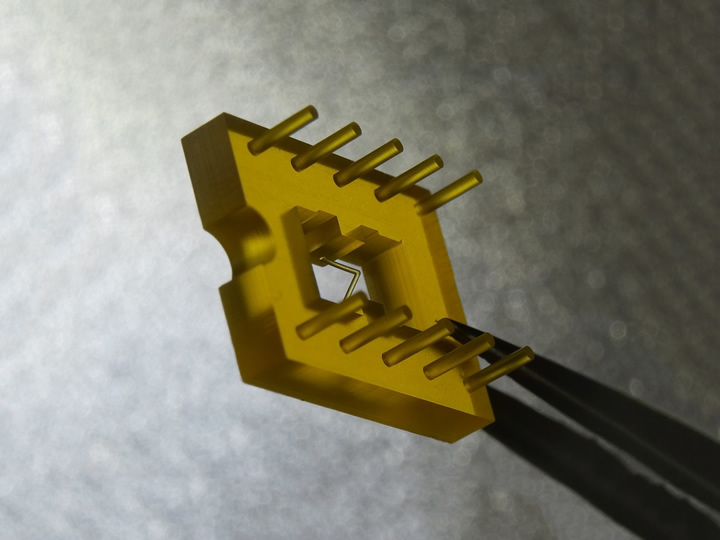HORIZON LAUNCHES BREAKTHROUGH TECHNOLOGY AT FORMNEXT 2022

During a busy and highly successful Formnext 2022 in Frankfurt, Horizon Microtechnologies commercially launched it ground-breaking template-based 3D-microfabrication technology, which produces conductive micro additive manufacturing (micro-AM) derived parts with micrometer scale precision.
Demonstrating its technology alongside micro-AM technology innovator Boston Micro Fabrication, CEO at Horizon Andreas Frölich showed attendees the company’s post-build processes which introduce the versatility of micro-AM to such applications as electrodes and electrical contact pins, ESD safe parts, 3D microfluidics, and MEMS and optics packaging for the very first time.
Frölich explains, “Template-based 3D microfabrication is effectively a mechanism to exploit the usefulness of polymer micro-AM produced 3D microstructures (the template) for hitherto unserved areas of industry by adding material and functionality to the microstructure, typically with a coating process. This is a real game changer for industry. The key enabling technology for our processes is micro-AM, and today a number of commercially viable polymer-based micro-AM platforms exist that can achieve exacting tolerances, quickly, cost-effectively, and above all repeatably. However, these platforms are almost exclusively restricted to the production of parts in resin or plastics. Horizon Microtechnologies bridges the gap between micro-AM and parts with enhanced functionality through the use of proprietary post-build processes. This means that companies requiring the flexibility, innovation, and agility that is driven by AM for parts with conductive, ceramic, heat-resistant, or other polymer-incompatible functionalities now have a commercially viable solution available.”
Horizon specialises in the production of micro-scale conductive parts and environmentally resistant parts. To introduce conductivity, once the part is produced on a polymer-AM platform, it is either wholly or selectively coated with a conductive layer. Horizon can even coat difficult areas homogeneously such as long narrow channel and undercuts. Obvious application areas include electrodes, electrical sensor heads, and ESD-safe components.
Microfabricated 3D templates can also be coated with metal-oxides to make parts compatible with aggressive chemical environments and in some cases can notably increase the resistance to high temperatures and mechanical stresses. This allows, for example, the fabrication of nozzles and 3D microfluidics for aggressive solvents and certain acids with the full design freedom of additive manufacturing. In some cases, it is also possible to make bulk ceramic or glass objects.
Frölich continues, “If you take a look at just one of the key application areas that our technologies are appropriate for (electrodes and electrical contact pins) you can see what Horizon’s solutions open up. By using our in-house technologies, we can design an electrode geometry almost arbitrarily while maintaining manufacturability. In comparison to manufacturing routes not based on micro-AM, this allows a broader set of options for requirements such as three-dimensional placement of the active electrode areas, stiffness (or lack thereof) of the electrodes, and electrical properties of the electrode due to the enhanced control over the inductance and capacitance. In addition, we can make electrodes with different conductive materials to cater for biocompatibility or bioinertness. The same benefits apply to the design and fabrication of electrical contact pins.”
When looking at ESD-safe parts, Horizon can make parts with a controllably conductive surface coating and coat internal channels with multiple bends. This allows the company to make very compact and high-performance end-effectors for vacuum pick-and-place devices which are at the same time conductive enough to prevent ESD-discharge. ESD safety also enables the use of Horizon produced parts under conditions requiring spark-freedom and explosion-protection.
In the area of microfluidics, the additive manufacturing approach lends itself very well to prototyping and small batch production of complex, multi-level microfluidic chips, including chips with integrated filters and interfaces to external components. Using Horizon’s post-print processes, the surfaces in contact with the liquid can be coated to improve wetting behaviour, control surface energy, or even introduce electrically conductive areas.
Finally, while AM is not typically considered a mass-production technology, the reduction in the size of electronics and optics — and the accompanying shrinkage of packaging — has made it a viable production alternative for MEMS and optics housings for small to medium batch sizes. In addition to the precision offered by micro-AM, an intelligent use of Horizon’s post-processes can increase the functionality of the packaging, for example by reducing stray light in the infrared, or by having integrated electrical conductors.
Frölich concludes, “These are exciting time for us all at Horizon as years of R&D have now culminated in us launching our technologies commercially. I think what makes us stand out as a company is our in-depth experience with production and design techniques in the 3D microfabrication ecosystem. We work in a supplier-independent fashion with polymer micro-AM technology innovators and have developed in-house post-build technological solutions that are an integral and important addition to the AM process chain — stimulating innovation and disrupting the manufacture of micro-scale conductive parts and components. We look forward to working with companies across numerous industry sectors that will benefit from our solutions.”
Comments (0)
This post does not have any comments. Be the first to leave a comment below.
Featured Product

